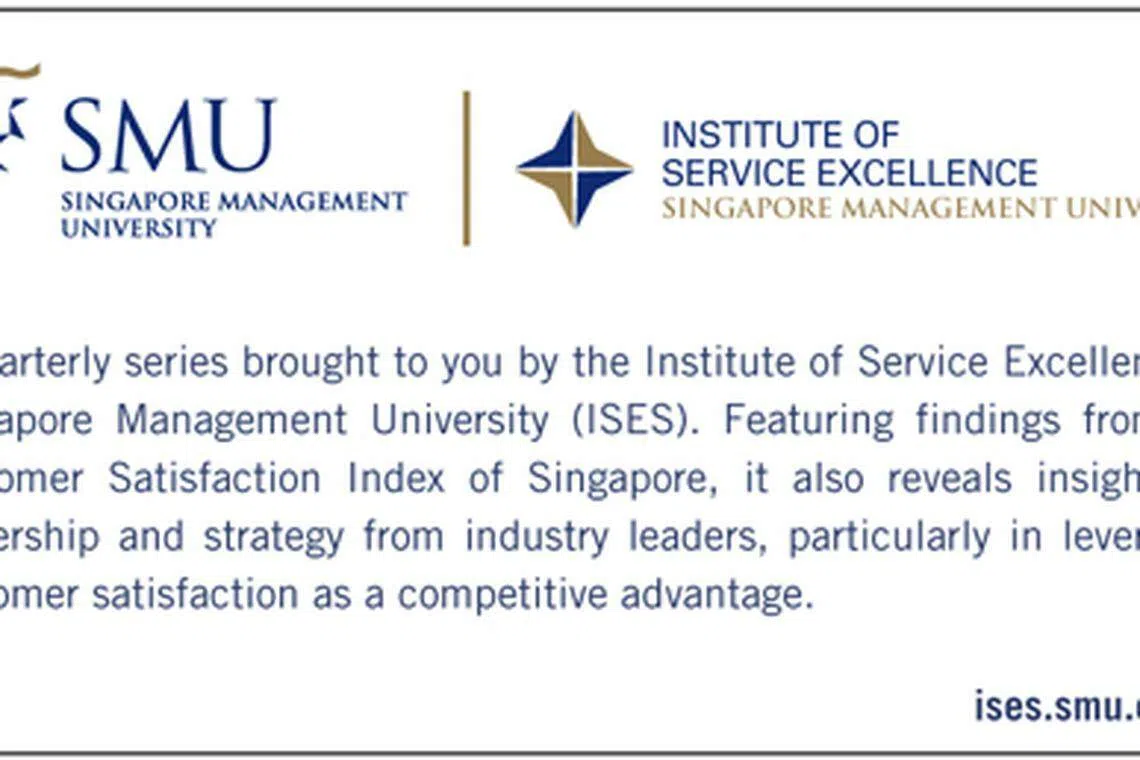Satisfaction levels and revenue are linked: ISES
The more satisfied customers are, the more they tend to spend.
THE Customer Satisfaction Index of Singapore (CSISG) is the only independent national measure of service levels across 11 economic sectors in Singapore. With the reporting of the CSISG 2016 first-quarter scores, the measured companies can keep track of how they are faring vis-à-vis their competitors, says Neeta Lachmandas, executive director of the Institute of Service Excellence at SMU (ISES).
Based on the premise that what gets measured gets done, the institute continues to recognise the impact of benchmarking and comparative analytics on company performance in terms of service experience delivery.
"The CSISG also reveals that satisfaction levels and revenue are positively correlated. Our data shows that the more satisfied customers are, the more they tend to spend and stay loyal," Ms Lachmandas says.
Given that the CSISG tracks the retail and infocomm sectors every year, the scores reveal how customers rate their experience with the measured companies over time. The movement in scores also highlights the dynamic nature and performance of service levels in Singapore over time.
"Companies measured in the CSISG do keep close watch over the scores as they reflect consumer sentiments," says Ms Lachmandas. "Some use the data from CSISG to triangulate with other research data points conducted through various methodologies such as service audits, feedback forms and NPS (net promoter scores). Together, the CSISG and these additional methodologies present a holistic picture of how a company is doing in terms of service performance."
Companies tend to celebrate improvements in their CSISG scores and look into their internal service design and delivery processes when they see a dip in the scores. This is because of the importance and value of service staff for a business and its competitiveness. Companies also realise that service can be leveraged as a business differentiator.
Says Ms Lachmandas: "In a world where goods are being increasingly commoditised and consumers are spoiled for choice, service is increasingly being leveraged as a business differentiator. Often, the difference between a good brand and a great brand lies in how much a business has invested in the design and delivery of its service.
"There are a few important trends and disruptors at play. The increase in technological adoption across the globe and the advent of social media have created a world that is more connected than ever before," Ms Lachmandas points out. "Consumers can now take their complaints and compliments online, add to a web of information and influence how a brand is being perceived by a fast-growing community of economically mobile and empowered individuals.
"People are more likely to believe what their peers tell them than what they see in an ad. Stories of shame or glory are communicated at the speed of light and are often beyond the control of businesses. What businesses can control is how consumers should experience their brands, what they can do to delight them and how to effectively resolve issues of disappointment or mismatched expectations."
ISES's executive director notes that some companies are able to keep their service staff for more than a decade or even longer. "Companies such as Singtel and DFS have managed to retain their service staff on their team for more than a decade. This boils down to a couple of key attributes: recognition and promotion, mentorship and empowerment as well as an empathetic environment to work in," says Ms Lachmandas.
"These attributes translate to how much the company values the individual. Recognition and promotion answer to the need for career progression; mentorship and empowerment reflect an emphasis on learning, rapport and trust. An empathetic environment reflects care."
Given Singapore's economic environment, businesses need to focus on promoting service excellence even more.
"Companies should not be afraid to experiment: test, fail fast and fail cheap, refine and try again. Knowing that consumers are increasingly used to speed, convenience, personalisation as well as product or service on demand, companies should revamp their business models to reflect these attributes in service delivery," says Ms Lachmandas.
"Service excellence is no longer about physical cues such as smiling, bowing or timely greeting. It is about meeting changing needs and being able to adapt the way of doing business around those needs."
A new development for many businesses is the need to have an omnipresence strategy. Omni-channel is a cross-channel business model that companies use to increase customer experience. Says Ms Lachmandas: "The need for omni-channel arises because consumers are increasingly plugged into multiple devices and platforms in daily life.
"In the past, shopping takes place in brick-and-mortar stores. Today, shopping can happen over the computer or on the phone. The experience of a brand should maintain a certain level of consistency across platforms and channels.
"From a resource optimisation perspective, companies should also aim to achieve synergies rather than allow for duplication to happen across channels."

BT is now on Telegram!
For daily updates on weekdays and specially selected content for the weekend. Subscribe to t.me/BizTimes
New Articles
HDB resale prices accelerate, rising 1.8% in Q1 on stronger demand
Digital Core Reit Q1 distributable income slips 2.4% to US$10.6 million
BT subscribers can now share 5 premium articles a month with unlimited number of non-subscribers
First Reit reports 3.2% lower Q1 DPU of S$0.006 amid interest rate, forex headwinds
Vietnam holds first gold auction in 11 years to stabilise market
How Hudson Yards went from ghost town to office success story
